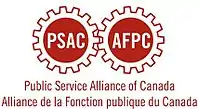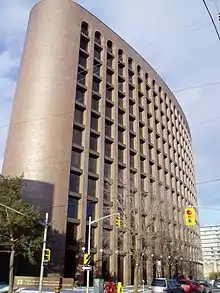Public Service Alliance of Canada
The Public Service Alliance of Canada (PSAC) is one of Canada's largest national labour unions and the largest union in the Canadian federal public sector. PSAC members work in every province and territory, and also work abroad in embassies and consulates.
 | |
| Full name | Public Service Alliance of Canada |
|---|---|
| Founded | 1966 |
| Members | 180,000 (2018)[1] |
| Affiliation | CLC, PSI |
| Key people | Chris Aylward, president |
| Office location | Ottawa, Ontario |
| Country | Canada |
| Website | www |

Many of PSAC's some 200,000 members work for the federal public service, crown corporations or agencies as immigration officers, fisheries officers, food inspectors, customs officers, national defence civilian employees, and the like. However, an increasing number of PSAC members work in non-federal sectors: in women's shelters, universities, security agencies and casinos. In Northern Canada, PSAC represents most unionized workers employed in the Yukon, Nunavut and the Northwest Territories.
PSAC's National President is Chris Aylward.
PSAC is headquartered in Ottawa with 23 regional offices across Canada. PSAC's Ottawa headquarters building, designed in 1968 by Paul Schoeler, is a notable example of modernist architecture in Ottawa.[2]
History
PSAC was formed when the Civil Service Association of Canada, led by Calbert Best, and Civil Service Federation of Canada, led by Claude Edwards, agreed to merge. Claude Edwards was elected as the first PSAC president. PSAC's founding convention took place at Ottawa's Chateau Laurier in 1966.
Bargaining
PSAC signed its first collective agreements with Treasury Board in 1968. By 2015, the union was negotiating 316 separate collective agreements under federal, provincial and territorial jurisdictions.
Strikes
PSAC's first strike came in November 1971 against Defence Construction Ltd. In 1980, the PSAC's large CR bargaining unit, made up largely of women clerical workers, went out on in Canada's biggest single bargaining unit work stoppage. PSAC's 1991 general strike, the largest single union strike in Canadian history, brought job security improvements.
Women in the union
Most founding convention delegates were men. In 1967, PSAC began organizing secretaries, stenographers and typists. By 1976, PSAC had abolished the practice of tying a secretary’s salary to the rank of her boss (a practice known as "rug-ranking"), created an Equal Opportunities Committee to address women's issues and elected Aileen Manion, PSAC's first female national officer.
Equality rights
From 1981 onward, PSAC's Equal Opportunities Committee included all equity-seeking groups. In 1988, PSAC adopted a comprehensive human rights policy. Action committees for members with disabilities and racially visible members started in 1990. By 1999, the union started holding conferences for racially visible members, Aboriginal Peoples and workers with disabilities. In 2004, the first network of Aboriginal, Inuit and Metis members was formed to advance their rights within and beyond the union.
Executive
The National President, the National Executive Vice-President and the seven Regional Executive Vice-Presidents form the Alliance Executive Committee (AEC). The AEC is responsible for the day-to-day decisions of the union with respect to finances, overseeing campaigns, mobilizing the membership, advocating on behalf of the membership and advancing the union and its members' rights in the workplace. The AEC meets monthly and as needed.[4]
The current REVPs are:
- Colleen Coffey, Regional Executive Vice-President, Atlantic
- Yvon Barrière, Regional Executive Vice-President, Québec
- Alex Silas, Regional Executive Vice-President, National Capital Region
- Sharon DeSousa, Regional Executive Vice-President, Ontario
- Marianne Hladun, Regional Executive Vice-President, Prairies
- Jamey Mills, Regional Executive Vice-President, British Columbia
- Jack Bourassa, Regional Executive Vice-President, North
Components
- Agriculture Union (AU/PSAC) formerly the Canada Agriculture National Employees Association (CANEA) charter union
- Canada Employment and Immigration Union (CEIU/PSAC) charter union
- Customs and Immigration Union (CIU/PSAC) charter union
- Government Services Union (GSU/PSAC) joined after the merger in 1999 with the former Union of Public Works Employees and Supply and Services Union
- Nunavut Employees Union (NEU/PSAC) joined in 1999, previously members had belonged to the UNW
- Union of Canadian Transportation Employees (UCTE/PSAC) charter union – merged with the Natural Resources Union in 2017
- Union of Health and Environment Workers (UHEW/PSAC)formed by a merger of the Union of Environment Workers and the National Health Union in 2016
- Union of National Defence Employees (UNDE/PSAC) charter union
- Union of National Employees (NE/PSAC) (formerly the National Component) charter union
- Union of Northern Workers (UNW/PSAC) joined in 1970
- Union of Postal Communications Employees (UPCE/PSAC) joined in 1967, successor to the former Canadian Railway Mail Clerks Federation
- Union of Solicitor General Employees (USGE/PSAC)
- Union of Taxation Employees (UTE/PSAC) charter union
- Union of Veterans Employees (UVE/PSAC) charter union
- Yukon Employees Union (YEU/PSAC) joined in 1990
Presidents
- Chris Aylward (UTE) 2018–present[5]
- Robyn Benson (UTE), 2012–2018
- John Gordon (GSU), 2006–2012
- Nycole Turmel (CEIU), 2000–2006
- Daryl Bean (PWU/GSU), 1985–2000
- Pierre Samson (CEIU), 1982–1985
- Andy Steward (AU), 1976–1982
- Claude Edwards, Civil Service Federation of Canada (CSFC), 1966–1976[6][7]
Regions
- Atlantic
- British Columbia
- National Capital Region
- North
- Ontario
- Prairies
- Québec
References
- http://psacunion.ca/about
- "Architect took risks to modernize Canada". Ottawa Citizen. Canwest Global. Retrieved 2009-10-08.
- A line through time: PSAC’s 50 years of solidarity
- http://psacunion.ca/elected-officers
- "Chris Aylward, National President". Public Service Alliance of Canada.
- "Remembering the life of Claude Edwards". ottawacitizen.remembering.ca.
- http://psacunion.ca/past-psac-presidents. Missing or empty
|title=(help)
External links
- Official website
- Public Service Alliance of Canada – Web Archive created by the University of Toronto Libraries
- About PSAC
- Alliance Executive Committee
- Agriculture Union
- Canada Employment and Immigration Union
- Customs and Immigration Union
- Government Services Union
- Nunavut Employees Union
- Union of Canadian Transportation Employees
- Union of Health and Environment Workers
- Union of National Defence Employees
- Union of National Employees
- Union of Northern Workers
- Union of Postal Communications Employees
- Union of Solicitor General Employees
- Union of Taxation Employees
- Union of Veterans Employees
- Yukon Employees Union